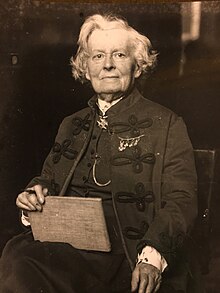
Back روسا بونهور Arabic روسا بونهور ARZ Роза Банёр BE-X-OLD Роза Боньор Bulgarian Rosa Bonheur BR Rosa Bonheur Catalan Maria Rosalia Bonheur Czech Rosa Bonheur CY Rosa Bonheur German Rosa Bonheur EO
Rosa Bonheur | |
|---|---|
 Rosa Bonheur, c. 1895–99 | |
| Born | Marie-Rosalie Bonheur 16 March 1822 Bordeaux, France |
| Died | 25 May 1899 (aged 77) Thomery, France |
| Known for | Painting, sculpture |
| Notable work | Ploughing in the Nivernais, The Horse Fair |
| Movement | Realism |
| Father | Oscar-Raymond Bonheur |
| Signature | |
Rosa Bonheur (born Marie-Rosalie Bonheur; 16 March 1822 – 25 May 1899) was a French artist known best as a painter of animals (animalière). She also made sculptures in a realist style.[1] Her paintings include Ploughing in the Nivernais,[2] first exhibited at the Paris Salon of 1848, and now in the Musée d'Orsay in Paris, and The Horse Fair (in French: Le marché aux chevaux),[3] which was exhibited at the Salon of 1853 (finished in 1855) and is now in the Metropolitan Museum of Art in New York City. Bonheur was widely considered to be the most famous female painter of the nineteenth century.[clarification needed][4]
It has been claimed that Bonheur was openly lesbian, as she lived with her partner Nathalie Micas for over 40 years until Micas's death, after which she lived with American painter Anna Elizabeth Klumpke.[5] However, others remark that nothing supports this claim.[6]
- ^ Carol Strickland; John Boswell (2007). The Annotated Mona Lisa: A Crash Course in Art History from Prehistoric to Post-Modern. Andrews McMeel Publishing. p. 83. ISBN 9780740768729.
- ^ "Musée d'Orsay: Rosa Bonheur Labourage nivernais". musee-orsay.fr. 25 March 2009. Archived from the original on 4 April 2019. Retrieved 24 October 2014.
- ^ "Rosa Bonheur | The Horse Fair". The Metropolitan Museum of Art.
- ^ Janson, H. W., Janson, Anthony F. History of Art. Harry N. Abrams, Inc., Publishers. 6th edition. ISBN 0-13-182895-9, page 674.
- ^ "10 Famous Female Painters Every Art Lover Should Know". My Modern Met. 30 August 2019. Retrieved 16 October 2020.
She was also an open lesbian, first living with partner Nathalie Micas for over 40 years and then, after Micas' death, forging a relationship with American painter Anna Elizabeth Klumpke. By living her life openly in an era when lesbianism was disparaged by the government, Bonheur staked her claim as a groundbreaking individual both in her career and her personal life.
- ^ "Rich, Famous and Then Forgotten: The Art of Rosa Bonheur". The New York Times. 17 October 2022. Retrieved 12 February 2023.
But Katherine Brault, the current owner of Bonheur's chateau, which is now a museum, says there is no proof that Bonheur was a lesbian. In another essay in the catalog, co-written with her daughter Lou, Brault characterizes Bonheur's relationship with Micas as an "act of independence and extraordinary sisterhood."(...)But Bonheur did not want to be a symbol for other women or for women's rights. Asked by an American newspaper in 1859 what she thought of the women's rights movement, she said, "Women's rights — women's nonsense! Women should seek to establish their rights by good and great works, and not by conventions."